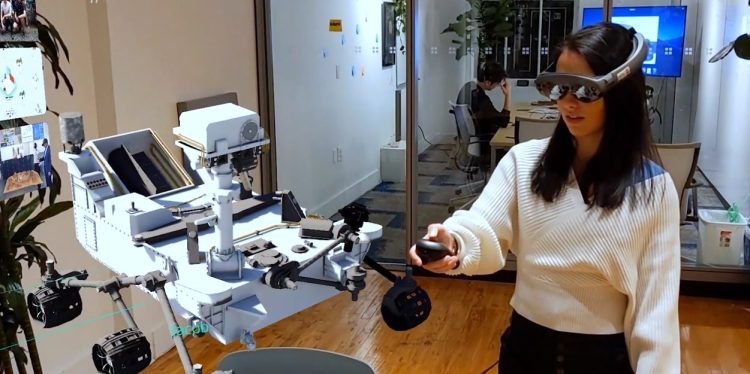testsetset
Although I cover the VR and AR industries with genuine enthusiasm, writing about Magic Leap has never been fun. The company radically overpromised what it would deliver as a user experience, created a product too expensive for consumers to buy, and barely found third-party developers willing to support its platform with apps. On the (very rare) occasions I’ve actually seen Magic Leap headsets in public, they’ve proved fidgety to wear, with small “augmented” viewing areas and only modestly interesting software.
Yesterday, we reported that Magic Leap was laying off an unspecified number of employees and sharpening its focus on enterprise opportunities, but its blog post didn’t do justice to what was happening. As affected employees took to social media, it became clear that the company was shuttering its consumer business and eliminating half of its workforce — around 1,000 people. “Pivot” is way too soft of a word to describe the carnage, and my heart broke for all the people whose jobs were lost yesterday.
It would be easy to describe the news as a sign of some broader disinterest in AR or mixed reality (XR) technologies, but that’s clearly not true. The coronavirus pandemic has made clear that XR devices will be highly useful for helping people work at home and participate in social gatherings without being physically present. Over the next few years, a CEO’s ability to lead a meeting holographically may be as plausible as Emperor Palpatine directing his minions from afar — science fact following science fiction, and possibly even becoming a symbol of tech savvy and status.
As much as I respect some of the talented people who work (or worked) at Magic Leap, it hasn’t ever struck me as a viable consumer AR device maker. I’ll give the company bravery points for daring to dream so big on augmented reality that it needed to create not only the glasses but also its own operating system, computing device, ecosystem, and “Magicverse” to power them. It also wins a boldness award for actually securing the funding, people, technologies, and manufacturing necessary to bring its vision to life. But throwing all the money in the world at Magic Leap was not going to result in a consumer product.
For the larger mixed reality industry, the problem was that much of the actually available XR investment money in the world had already been thrown at Magic Leap. XR startups routinely (and sometimes loudly) complained that they couldn’t get much or any funding for their projects because Magic Leap’s grand vision had sucked all the cash and energy out of the investing community. So there was a zero-sum game here to some extent; by exiting the consumer space, Magic Leap is simultaneously making its former consumer talent available to other XR companies and enabling investors interested in consumer AR to place their bets elsewhere — whenever they’re ready to spend cash again.
Magic Leap had a lot of hurdles to overcome as a consumer business, but most of them come down to the financial consequences of a tech startup trying to own the “whole stack” rather than just a piece of the pie. Instead of just getting into the AR glasses business, which has cost even the trillion-dollar Apple years of time and untold cash, Magic Leap built (and then had to convince people to buy) the computer and OS to power them. Average consumers might be willing to spend $500 on AR glasses, but Magic Leap set its initial price for developers at $2,300, then offered a $3,000 package in an effort to cover ongoing service costs.
For consumers, those numbers screamed “no way” from the start and never improved. If Magic Leap had relied on an existing mobile platform — iOS or Android — it could have focused on just getting the glasses right. That’s what Nreal is doing with its Light consumer AR glasses, which presume users will have a Qualcomm Snapdragon-powered phone running Android, enabling the glasses to hit a $500 price point. Developers who want to support Light can just build Android apps with Nreal-specific features, which makes a lot of sense, particularly for XR companies with limited coding resources.
Apart from Nreal, many companies in the XR space could benefit from an outflux of Magic Leap resources. Niantic — a proven success in smartphone-based AR — is apparently building its own hardware and software solution with support from Qualcomm, and it could pick up some of Magic Leap’s gaming talent. Lots of smaller developers could pick up individuals who have spent years of their lives working to solve big and little problems in the AR space ahead of broad consumer adoption.
And don’t shed a tear for Magic Leap. It has had billions of dollars at its disposal to tackle virtually every conceivable aspect of how augmented reality will impact daily life — a subject Apple, Facebook, and other well-funded tech companies continue to pursue in earnest, guaranteeing that AR will indeed become a big deal soon enough. Even after the layoffs, the company still has plenty of money, a thousand people, and major corporate backers (such as Google and AT&T) to help it focus on enterprise AR, which is more than most of its glasses-making rivals can say.
Magic Leap’s troubles aside, my gut feeling is that everything’s going to work out just fine for the XR industry as a whole. It’s clear at this point that the Magicverse won’t be at the center of everything. But once the dust settles, expect a big bang-class multiverse of competing and perhaps more viable visions, backed by more practical and affordable AR hardware.

